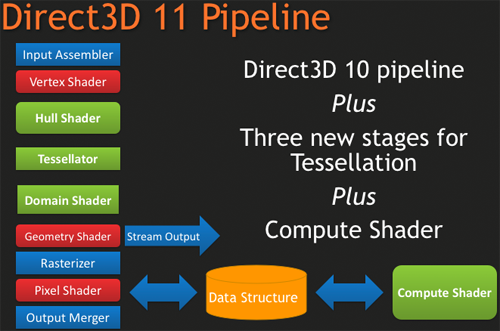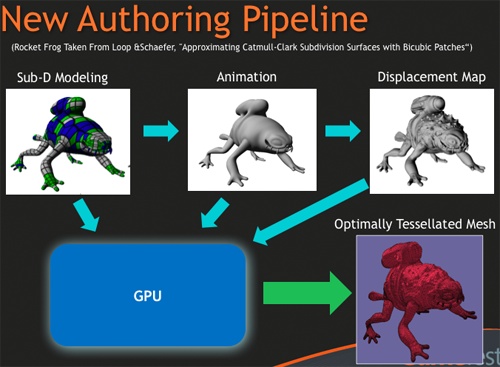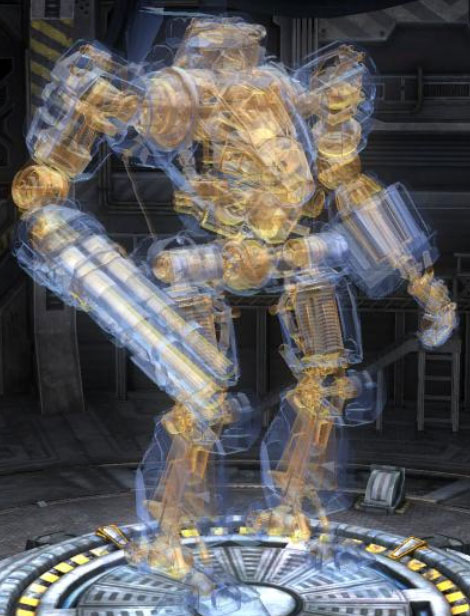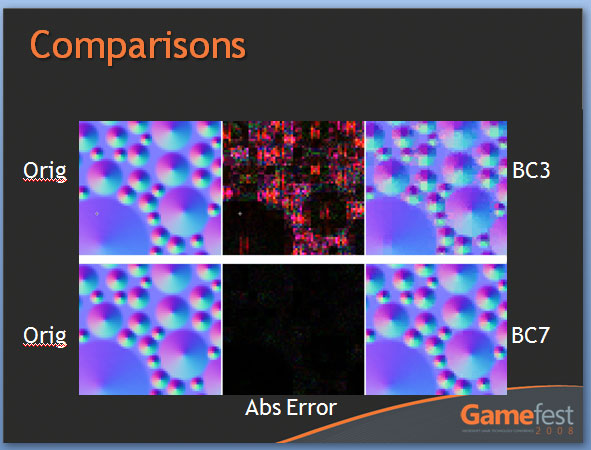AMD's Radeon HD 5870: Bringing About the Next Generation Of GPUs
by Ryan Smith on September 23, 2009 9:00 AM EST- Posted in
- GPUs
DirectX11 Redux
With the launch of the 5800 series, AMD is quite proud of the position they’re in. They have a DX11 card launching a month before DX11 is dropped on to consumers in the form of Win7, and the slower timing of NVIDIA means that AMD has had silicon ready far sooner. This puts AMD in the position of Cypress being the de facto hardware implementation of DX11, a situation that is helpful for the company in the long term as game development will need to begin on solely their hardware (and programmed against AMD’s advantages and quirks) until such a time that NVIDIA’s hardware is ready. This is not a position that AMD has enjoyed since 2002 with the Radeon 9700 and DirectX 9.0, as DirectX 10 was anchored by NVIDIA due in large part to AMD’s late hardware.
As we have already covered DirectX 11 in-depth with our first look at the standard nearly a year ago, this is going to be a recap of what DX11 is bringing to the table. If you’d like to get the entire inside story, please see our in-depth DirectX 11 article.
DirectX 11, as we have previously mentioned, is a pure superset of DirectX 10. Rather than being the massive overhaul of DirectX that DX10 was compared to DX9, DX11 builds off of DX10 without throwing away the old ways. The result of this is easy to see in the hardware of the 5870, where as features were added to the Direct3D pipeline, they were added to the RV770 pipeline in its transformation into Cypress.

New to the Direct3D pipeline for DirectX 11 is the tessellation system, which is divided up into 3 parts, and the Computer Shader. Starting at the very top of the tessellation stack, we have the Hull Shader. The Hull Shader is responsible for taking in patches and control points (tessellation directions), to prepare a piece of geometry to be tessellated.
Next up is the tesselator proper, which is a rather significant piece of fixed function hardware. The tesselator’s sole job is to take geometry and to break it up into more complex portions, in effect creating additional geometric detail from where there was none. As setting up geometry at the start of the graphics pipeline is comparatively expensive, this is a very cool hack to get more geometric detail out of an object without the need to fully deal with what amounts to “eye candy” polygons.
As the tesselator is not programmable, it simply tessellates whatever it is fed. This is what makes the Hull Shader so important, as it’s serves as the programmable input side of the tesselator.
Once the tesselator is done, it hands its work off to the Domain Shader, along with the Hull Shader handing off its original inputs to the Domain Shader too. The Domain Shader is responsible for any further manipulations of the tessellated data that need to be made such as applying displacement maps, before passing it along to other parts of the GPU.

The tesselator is very much AMD’s baby in DX11. They’ve been playing with tesselators as early as 2001, only for them to never gain traction on the PC. The tesselator has seen use in the Xbox 360 where the AMD-designed Xenos GPU has one (albeit much simpler than DX11’s), but when that same tesselator was brought over and put in the R600 and successive hardware, it was never used since it was not a part of the DirectX standard. Now that tessellation is finally part of that standard, we should expect to see it picked up and used by a large number of developers. For AMD, it’s vindication for all the work they’ve put into tessellation over the years.
The other big addition to the Direct3D pipeline is the Compute Shader, which allows for programs to access the hardware of a GPU and treat it like a regular data processor rather than a graphical rendering processor. The Compute Shader is open for use by games and non-games alike, although when it’s used outside of the Direct3D pipeline it’s usually referred to as DirectCompute rather than the Compute Shader.
For its use in games, the big thing AMD is pushing right now is Order Independent Transparency, which uses the Compute Shader to sort transparent textures in a single pass so that they are rendered in the correct order. This isn’t something that was previously impossible using other methods (e.g. pixel shaders), but using the Compute Shader is much faster.

Other features finding their way into Direct3D include some significant changes for textures, in the name of improving image quality. Texture sizes are being bumped up to 16K x 16K (that’s a 256MP texture) which for all practical purposes means that textures can be of an unlimited size given that you’ll run out of video memory before being able to utilize such a large texture.
The other change to textures is the addition of two new texture compression schemes, BC6H and BC7. These new texture compression schemes are another one of AMD’s pet projects, as they are the ones to develop them and push for their inclusion in DX11. BC6H is the first texture compression method dedicated for use in compressing HDR textures, which previously compressed very poorly using even less-lossy schemes like BC3/DXT5. It can compress textures at a lossy 6:1 ratio. Meanwhile BC7 is for use with regular textures, and is billed as a replacement for BC3/DXT5. It has the same 3:1 compression ratio for RGB textures.
We’re actually rather excited about these new texture compression schemes, as better ways to compress textures directly leads to better texture quality. Compressing HDR textures allows for larger/better textures due to the space saved, and using BC7 in place of BC3 is an outright quality improvement in the same amount of space, given an appropriate texture. Better compression and tessellation stand to be the biggest benefactors towards improving the base image quality of games by leading to better textures and better geometry.
We had been hoping to supply some examples of these new texture compression methods in action with real textures, but we have not been able to secure the necessary samples in time. In the meantime we have Microsoft’s examples from GameFest 2008, which drive the point home well enough in spite of being synthetic.

Moving beyond the Direct3D pipeline, the next big feature coming in DirectX 11 is better support for multithreading. By allowing multiple threads to simultaneously create resources, manage states, and issue draw commands, it will no longer be necessary to have a single thread do all of this heavy lifting. As this is an optimization focused on better utilizing the CPU, it stands that graphics performance in GPU-limited situations stands to gain little. Rather this is going to help the CPU in CPU-limited situations better utilize the graphics hardware. Technically this feature does not require DX11 hardware support (it’s a high-level construct available for use with DX10/10.1 cards too) but it’s still a significant technology being introduced with DX11.
Last but not least, DX11 is bringing with it High Level Shader Language 5.0, which in turn is bringing several new instructions that are primarily focused on speeding up common tasks, and some new features that make it more C-like. Classes and interfaces will make an appearance here, which will make shader code development easier by allowing for easier segmentation of code. This will go hand-in-hand with dynamic shader linkage, which helps to clean up code by only linking in shader code suitable for the target device, taking the management of that task out of the hands of the coder.










327 Comments
View All Comments
T2k - Thursday, September 24, 2009 - link
Just whatF are you talking about, seriously? Is this some kind of new urban BS again?
Look at other sites, they DID test it with ET:QW:
http://www.techpowerup.com/reviews/ATI/Radeon_HD_5...">http://www.techpowerup.com/reviews/ATI/Radeon_HD_5...
http://www.xbitlabs.com/articles/video/display/rad...">http://www.xbitlabs.com/articles/video/display/rad...
and so on. BTW L4D is a passing fart in the wind while ET:QW is still going strong, stronger than UT3 (unfortunately because UT3 looks 10x better and the old ONS mode was awesome but Epic fucked it in UT3)
Read other reviews before you post:
http://forums.anandtech.com/messageview.aspx?catid...">http://forums.anandtech.com/messageview...amp;thre...
SiliconDoc - Wednesday, September 30, 2009 - link
I see by your review links the 5870 just doesn't do well in ET:QW, everything else is closer to it and it gets beat worse, at 2560 high aa&af GTX295 slams it by 20%, so, of course, it was left out, in order to "pump up the percieved red number".-
It's "not a good appearance".
You'll just have to live with it for now like the rest of us.
number58 - Wednesday, September 23, 2009 - link
Is this card any closer to saturating the pci-express 2.0 x16 slot? That was one of the big arguments in the P55 vs X58 debate. Would there be any loss of performance using these in crossfire on P55 compared to X58?Otherwise, great article. I think I'll be hanging on to my 4890 for a while though.
Kaleid - Wednesday, September 23, 2009 - link
Look here for an answer:http://www.techpowerup.com/reviews/AMD/HD_5870_PCI...">http://www.techpowerup.com/reviews/AMD/HD_5870_PCI...
number58 - Wednesday, September 23, 2009 - link
Thanks. That just about settles it. My next system will be Lynnfield based.Zeratul - Wednesday, September 23, 2009 - link
Please add support for Stereoscopic 3D, ATI. I'm not going back to play games in 2D, though I don't like nvidia's monopoly in that.Arbie - Wednesday, September 23, 2009 - link
Not just a review but an excellent technical discussion. It must have been a lot of work. Thanks for all of that, and do please follow up where you can on people's requests for more info on this very important card.Kudos to ATI/AMD for such an achievement. It looks like Nvidia is in big trouble.
Arbie
SiliconDoc - Wednesday, September 23, 2009 - link
rofl - Nvidia is in big trouble ? LOLHave you looked at the charts on wiki that predicted what this review shows ? Maybe you should take a gander at the Nvidia chart, now, and cry.
--
It is a nice review, although biased red here as usual.
--
I'd like to mention as he fretted about heat because of the 1/2 vent on the back of the card, I didn't notice overt despairing mention of the TWO rectangular exhaust ports on the fan end BLOWING HEAT INTO THE CASE.... which of course is deserved. Nice how that was held back as if overlooked. (Boy what trouble for Nvidia! hahha)
Next we'll be told the red rooster tester put his hand next to the two internal exhaust ports, and "the air felt rather cool" so "rest assured not much heat is being pushed into your case", and "this doesn't matter".
See, the trouble is already in the article, the trouble it took to spin it just so for Ati... lol... it's hilatrious!
ClownPuncher - Wednesday, September 23, 2009 - link
Bizzarro SnakeOil, is that you?SiliconDoc - Wednesday, September 23, 2009 - link
No, this is me, the same me I've always been.Would you like to comment on the two internal exhaust ports of the 5870 that put sweltering heat into your case ?
I guess you tried to ignore that entirely.
You can always insult me again and avoid commenting on the heating exhaust ports ramping up your case temps on the 5870...
That of course would be "the right thing to do".
Perhaps call me crazy, and avoid the topic, right, you're good at that, huh.